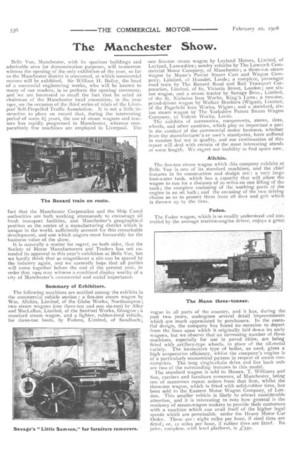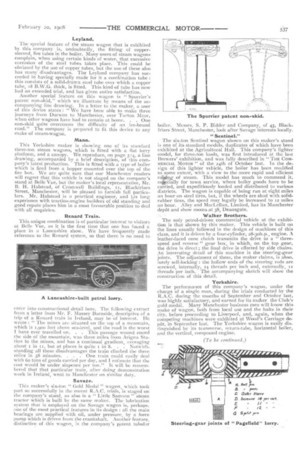The Manchester Show.
Page 20

Page 21

If you've noticed an error in this article please click here to report it so we can fix it.
Belle Vue, Manchester, with its spacious buildings and admirable area for demonstration purposes, will to-morrow witness the opening of the only exhibition of the year so far as the Manchester district is concerned, at which commercial motors will be exhibited. Sir William H. Bailey, the head of a successful engineering works, who will be known to many of our readers, is to perform the opening ceremony, and we are interested to recall the fact that he acted as chairman of the Manchester local committee, in the year igoi, on the occasion of the third series of trials of the Liverpool Self-Propelled Traffic Association. It is not a little instructive to place on record that, during the intervening period of some 61 years, the use of steam wagons and tractors has rapidly progressed in Manchester, whereas comparatively few machines are employed in Liverpool. The
fact that the Manchester Corporation and the Ship Canal authorities are both working strenuously to encourage all fresh transport facilities, and Manchester's geographical position as the centre of a manufacturing district which is unique in the world, sufficiently account for this remarkable development, and one which augurs most favourably for the business value of the show.
It is naturally a matter for regret, on both sides, that the Society of Motor Manufacturers and Traders has not extended its approval to this year's exhibition at Belle Vue, but we hardly think that so magnificent a site can be spared by the industry again, and we earnestly hope that all parties will come together before the end of the present year, in order that oaoa may witness a combined display worthy of a city of Manchester's commercial and social importance.
Summary of Exhibitors.
The following machines are notified among the exhibits in the commercial vehicle section : a-five-ton steam wagon by Wm. Allchin, Limited, of the Globe Works, Northampton; two steam wagons (One three-ton and one six-ton) by Alley and MacLellan, Limited, of the Sentinel Works, Glasgow; a standard steam wagon, and a lighter, rubber-tired vehicle, for three-ton loads, by Fodens, Limited, of Sandbach;
one five-ton steam wagon by Leyland Motors, Limited; of Leyland, Lancashire; sundry vehicles by The Lowcock Commercial Motor Company, of Manchester; a three-ton steam wagon by Mann's Patent Steam Cart and Wagon Company, Limited, of Hunslet, Leeds; a complete, passenger road train by The Renard Road and Rail Transport Corporation, Limited, of 82, Victoria Street, London; one sixton wagon, and a steam tractor by Savage Bros., Limited, of the St. Nicholas Iron Works, king's Lynn; a two-ton, petrol-driven wagon by Walker Brothers (Wigan), Limited, of the Pagefield Iron Works, Wigan; and a standard, sixton steam wagon by The Yorkshire Patent Steam Wagon Company, of Vulcan Works, Leeds, The exhibits of accessories, components, stores, tires, wheels, and other sundries, which play so important a part in the conduct of the commercial motor business, whether from the manufacturer's or user's standpoint, have suffered in number but not in quality, and our-continuation of this report will deal with certain of the most interesting stands at some length. We regret our inability to find space now.
AUchin.
The five-ton steam wagon which this company exhibits at Belle Vue is one of its standard machines, and the chief features in its construction and design are : a very large feed-water tank, which has a capacity that will allow the wagon to run for a distance of 20 miles on one filling of the tank ; the complete enclosing of the working parts of the engine in an oil bath; and the encasing of the two driving chains so as to protect them from all dust and grit which is thrown up by the tires.
Foden.
The Foclen wagon, which is so readily understood and 6op, trolled by the average traction-engine driver, enjoys .a great vogue in all parts of the country, and it has; during the past two years, undergone several detail improvements which are much appreciated by purchasers. In the essential design, the company has found no occasion to depart from the lines upon which it originally laid down its early wagons, but we observe that an increasing number of these machines, especially for use in paved cities, are being fitted with artillery-type wheels, in place of the all-metal variety. The locomotive type of boiler, as used, gives a high evaporative efficiency, whilst the company's engine is of a particularly economical pattern in respect of steam consumption. The long single-chain drive and live back axle are two of the outstanding features in this model. The standard wagon is sold to Messrs. T. Williams and Son, carriers and furniture removers, of Manchester, being one of numerous repeat orders from that firm, whilst the three-ton wagon, which is fitted with solid-rubber tires, has been sold to the Eastern Motor Wagon Company, of London. This smaller vehicle is likely to attract considerable attention, and it is interesting to note how general is the tendency of steam-wagon makers to provide their customers with a machine which can avail itself of the higher legal speeds which are permissible under the Heavy Motor -Car. Order. These are : eight miles per hour, if Steel tires are fitted; or, 12 miles per hour, if rubber tires are fitted. Its price, complete, with level platform, is .1:55o.
Leyland.
The special feature of the steam wagon that is exhibited by this company is, undoubtedly, the fitting of coppersleeved, fire tubes in the boiler. Many users of steam wagons complain, when using certain kinds of water, that excessive corrosion of the steel tubes takes place. This could be obviated by the use of copper tubes, but the use of these also has many disadvantages. The Leyland company has succeeded in having specially made for it a combination tube : this consists of a solid-drawn steel tube over which a copper tube, 18 B.W.G. thick, is fitted. This kind oftube has now had an extended trial, and has given entire satisfaction, Another special feature on this wagon is " Spurrier's patent non-skid," which we illustrate by means of the accompanying line drawing. In a letter to the maker, a user of this device states : " We have been able to make three journeys from Darwen to Manchester, over Turton Moor, when other wagons have had to remain at home. . . One non-skid quite overcomes the difficulty of an ice-bound road." The company is prepared to fit this device to any make of steam-wagon.
Mann.
This Yorkshire maker is showing one of its standard three-ton steam wagons, which is fitted with a flat lorry platform, and a canopy. We reproduce, on page 5.4, a line drawing, accompanied by a brief description, of this company's latest production. This is fitted with a type of boiler which is fired from a hopper mounted over the top of the fire box. We are quite sure that our Manchester readers will regret that this vehicle is not staged on the company's stand at Belle Vue, but the maker's local representative, Mr. B. H. Halstead, of Cromwell Buildings, it, Blacktriars Street, Manchester, will be pleased to furnish full particulars. Mr. Halstead is a practical engineer, and his long experience with traction-engine builders of old standing and good repute places him in a most favourable position to deal with all enquiries.
Renard Train.
This unique combination is of particular interest to visitors at Belle Vue, as it is the first time that one has found a place in a Lancashire show. We have frequently made reference to the Renard system, so that there is no need to enter into constructional detail here. The following extract front a letter from Mr. F. Massey Burnside, descriptive of a trip of a Renard train in Ireland, ma Y be of interest, lie wrote : " The mines are situated on the top of a mountain, which is 1,900 feet above sea-level and the road is the worst I have ever travelled on. . . This passage wound round the side of the mountain, was three miles from Arigna Station to the mines, and has a continual gradient, averaging about i in II, but at places is quite i in 8. . . Notwithstanding all these disadvantages the train climbed the three miles in 58 minutes. . . . One train could easily deal with Go tons of goods carried per day, and I estimate that the cost would be under sixpence per ton." It will be remembered that that particular train, after doing demonstration work in Ireland, went to Manchester on similar duty.
Savage.
This maker's six-ton " Gold Medal " wagon, which took part so successfully in the recent R.A.C. trials, is staged on the company's stand, as also is a " Little Samson " steam tractor which is built be the same maker. The lubrication system that is employed on the Savage wagon is, perhaps, One of the most practical features in its design : all the main bearings are supplied with oil, under pressure, by a force pump which is driven from the crankshaft. Another feature, distinctive of this wagon, is the .company's patent tubular
boiler. Messrs. S. P. Bidder and Company, of 45, Blackfriars Street, Manchester, look after Savage interests locally.
"Sentinel."
The six-ton Sentinel wagon shown on this maker's stand is one of its standard models, duplicates of which have been exhibited at the Agricultural Hall. This company's lighter model, for three-ton loads, was first introduced at the last Brewers' exhibition, and was fully described in L THE COM MERCIAL Moron" of the 24th of October last, In the design of this lighter vehicle, the boiler has been modified to some extent, with a view to the more rapid and efficient rang of steam. This model has much to commend it, esgreially. for town service, where bulky goods have to be carried, and expeditiously loaded and distributed to various districts. The wagon is capable of being run at eight mites an hour on steel tires, but, if the wheels are shod with solidrubber tires, the speed may legally be increased to 12 miles an hour. Alley and MacLellan, Limited, has its Manchester depot and show rooms at 38, Deansgate.
Walker Brothers.
The only petrol-driven commercial vehicle at the exhibition is that shown by this maker. This vehicle is built on the lines usually followed in the design of machines of this class, and it is driven by a four-cylinder, 28-3oh.p., engine. A leather-faced cone clutch transmits the drive to a " threespeed and reverse" gear box, in which, on the top gear, the drive is direct ; the final drive is effected by side chains. An interesting detail of this machine is the steering-gear joints. The adjustment of these, the maker claims, is absolutely self-locking.: the hollow ends of the steering rods are screwed, internally, 14 threads per inch and, externally, II threads per inch. The accompanying sketch will show the construction of this detail.
Yorkshire.
The performance of this company's wagon, under the charge of a single man, during the trials conducted by the R.A.C. during the months of September and October last, was highly satisfactory, and earned for its maker the Club's gold medal. Many Manchester business men will know this make of wagon, both from local use and the halts in their city, before proceeding to Liverpool, and, again, when the competing machines were exhibited at Wood's Carriage depot, in September last. The Yorkshire wagon is easily dis. tinguished by its transverse, return-tube, horizontal boiler, and the vertical, compound engine.




























